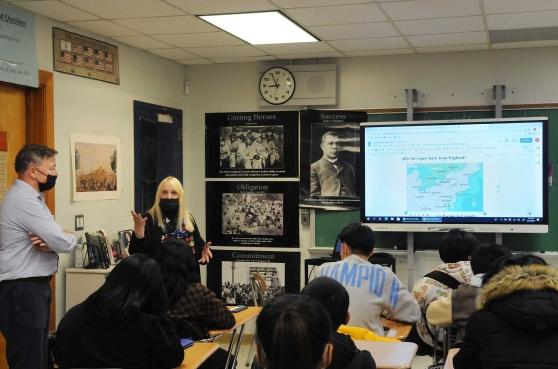Tour de force

Teachers John Hunt and Pamela King lead their students at the HS of Economics and Finance in Manhattan on a virtual tour of New York State.
When Pamela King takes her students on a tour of New York State, there’s no telling where they’ll end up. They might discover Corning Incorporated, formerly known as the Corning Glass Works, which produces the sturdy glass for iPhones and other digital devices in the city of the same name. They might explore the Morton Salt Mine under Lake Erie. Or they might visit the city of Rochester, where Frederick Douglass helped Black men and women escape slavery by crossing into Canada.
The beauty of the adventures is that they are part of a Virtual Tour of New York State that can be accessed on students’ digital devices at the HS of Economics and Finance in lower Manhattan, where King teaches English as a second language. King says the idea grew out of the pandemic lockdown of 2020 and involved lengthy discussions with her co-teacher, John Hunt, who is a historian. King was remote, and Hunt was teaching in person when classes resumed that September.
“How can we take them out of their houses? That was the point and, as we went on, we both learned so much about New York State,” King said. “John knew all about the battle of Saratoga and Ticonderoga, and he knew about the YouTube programs on those topics that would grab their attention. I brought the stories and the poetry.”
Each would get ideas and search for related content online. The result was a Google Doc of more than 1,500 pages, with links to living history museums and other videos that students can access in the classroom and on their devices.
“We found living history museums that depict life in 1876, for example, with people dressed in the era’s fashions talking about the times, whether it’s about making syrup or how to make a canoe or pottery,” said King.
The virtual tour touches all points of New York State.

Among the topics discussed is how Frederick Douglass helped Black men and women escape slavery by crossing into Canada.
“The tour begins with the Native Americans going up the Hudson River to Lake George, Lake Champlain, the Adirondacks,” King said, “and then comes down to the Catskills, the Erie Canal, with Syracuse, Rochester and Buffalo. Then we went across the center of the state and the south as well, ending up at Lake Erie. Finally, we toured Long Island.”
The second half of the tour focuses on New York City's five boroughs and its neighborhoods.
King came up with the concept, said Hunt, “and we kept doing research, and it kept building and building.”
Together, they also modeled a valuable lesson for their students: how to conduct research. Students were called upon to do further reading on the topics and to write about what they learned after viewing the travelogue.
For ESL students, the visual entryway to the lessons got them hooked, and the lessons helped them to improve their English skills. Students who come from Ecuador, Mexico, Pakistan, Bangladesh and China, among other places, were required to research both their local neighborhoods and their home countries.
Anyi, a 17-year-old sophomore, said she was taken with the facts about slavery. “How people treated Blacks in different places, how much was paid to free Blacks and, even then, freedom wasn’t guaranteed,” she said.
When it was her turn to share personal history with fellow students, Anyi told them about the Dominican Republic, the country she emigrated from nine years ago. “Santo Domingo, the capital, was the first city in the Caribbean, where the Spaniards went first,” she said.
For Vezir, 15, also a sophomore, the images were the draw. “It’s more fun to view everything,” he said. “It can be overwhelming to read about it, but with the travelogue, everything clicks.” He was especially fascinated by the story of how Frederick Douglass went to Rochester to help Blacks escape to Canada.
“I learned a lot,” said 17-year-old Fangqi, a senior who arrived from China three years ago. “The travelogue also helped me a lot with grammar and understanding irregular verbs.”
The class has also kindled wanderlust. “I asked the students, if time and money were no object, where would you go?” said Hunt. The answers included Lake Placid, the Adirondacks and Watkins Glen Falls, where the striations of rocks date from the era of dinosaurs, the students learned.
“It opened up their vision and their minds and changed their mindset,” Hunt said. It also gave them a better idea of what their home state is all about. “People are drawn to New York for reasons to do with freedom and civil rights,” said King.
For newcomers, getting the lay of the land is important. “It anchors them,” said Hunt.
The Virtual Tour of New York State was built around the four skills for English language learners: reading, writing, listening and speaking. The material, which is free for educators in New York State, can be used for curriculum for after-school classes as well as summer enrichment programs. If you have any questions about the Virtual Tour of New York State, you may reach out to the two New York City teachers who assembled it at nysvirtualtour@gmail.com.